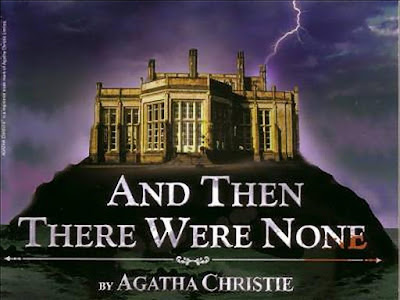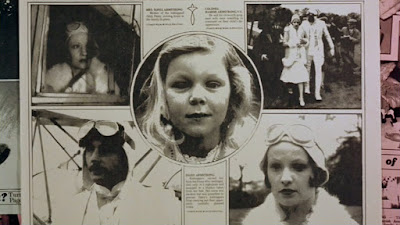I'm a huge fan of Agatha Christie since I was little. I've recently seen the BBC adaption of "And then there were none", one of my favourite AC's books and I've been compelled to write down this nonsense. I have a major degree in psychology so sometimes it takes over when I write about book/movie characters but, in this case, this crap is mostly about the fact that I enjoyed (loved - really) this adaptation- enjoy.
---
 The funny
thing about Agatha Christie's novels is that she pinpoints her characters
albeit she rarely offers a psychological evaluation of their motives or
actions.
The funny
thing about Agatha Christie's novels is that she pinpoints her characters
albeit she rarely offers a psychological evaluation of their motives or
actions.
I mean, she
describes what they've done and tells us why they did it, that's it.
She let us into the character psychology by describing their reaction but she rarely describe the inner rummaging of her characters. Nevertheless, she always makes them believable.
She let us into the character psychology by describing their reaction but she rarely describe the inner rummaging of her characters. Nevertheless, she always makes them believable.
Let's
examine Vera Claythorne for instance. AC doesn't waste pages
describing the feelings of this character towards what she has done but instead she shows Vera freaking out when a sea weed touches her and she automatically thinks of
Cyril's dead hand.
This writer
doesn't told us how the character feel she lets us presume that much and, as in
Hitckok movies, our imagination will play on our own chords to draws out our fears or, in this case, emotion. Perception
of human emotion, to be fair.
We have to
remember AC was a victorian novelist in the victorian era with a soft side for romance. In most novels there is a love story running parallel to the
investigation although she is not one to elaborate feelings: it's not her writing style.
She doesn't really do it even in her romance novels, written under the pen name of Mary Westmacott.
She doesn't really do it even in her romance novels, written under the pen name of Mary Westmacott.
At the end
of the day, AC's books have the advantage to give directors
emotional clean characters so they can play around with their feelings as
much as they like.
And then
there were none, polite adaptation for the former title "ten little
niggers", introduces only ten
characters who, unlike AC's other novels, don’t share a past. They all are
independent.
And then there were none (BBC
2015)
book cover
It’s a refreshing
turn of events from Christie’s usual plots where there are so many hidden
secrets in the character’s pasts and they are usually revealed only by the end
of the book, if not when the murderer is unmasked.
There are
ten, nine to be correct since two characters are a couple prior to the
beginning of the story, different background stories.
There is
one precise moment - when they are confronted with their crimes - in which
their personal storylines intersects and from that moment on, we have ten
people forced to be on their own whilst being honest about their darkest secrets.
And then there were none
(1945 by René Claire) B/W USA
AC gives
us people who have done pretending – such a novelty for a crime story - but for all their honesty, they cannot allow
themselves to put their trust in anyone
on the island. And even though this characters are honest to the core and
desperately trying to work out their comprehensible mistrust in their
companions, we all know how it ends.
I actually
like the simple fact that they all are murderers so they get at a deep level
why they cannot befriend anyone.
Ten little indians (1965 by george Pollock) B/W UK
On the
screen, actors play out or conceal those
emotions and it is up to them what to really show. AC’s characters
from the book are cut-outs the actors have to paint, sometimes even to embellish.
But “And then there were none” is hardly only about characters.
It’s about
the setting and it is about fear but, most of all, it is about justice. I think
Lady Christie really believed in justice and she wanted it to be served no
matter what. "And then there were none" characters are all criminals and they die one by one
according to the severity of their crimes.
And then there were none (BBC
2015)
At some
point you like them, you feel for them - trapped and hunted down - so you almost forget no one is innocent in
this story and the ones still alive are
so because their crimes are the worst and the murderer wants them to suffer the
most.
“And then there were none” is a story of growing paranoia and distrust ‘till the sad end.
I said sad but, really, truth is they all deserved what they got. It is true especially for the last two “niggers/Indians”.
I said sad but, really, truth is they all deserved what they got. It is true especially for the last two “niggers/Indians”.
And then there were none (BBC
2015)
Vera and Philip deserve to die, no doubts.
She committed the worst crime of the all gathering of murderers and he has no remorse for his past actions. However, he is a mercenary, a gun to hire, we may understand him – somehow – but there are no excuses for Vera killing a young boy so his lover could inherit and she could marry a rich man. She is the last to die and I couldn’t agree more with it nor I could love more the final scene when she takes her on life.
What about Phillip then? As I told before, he doesn’t regret what he’s done. So, where is the real justice in killing him?
This may be the finest example of Agatha Christie’s genius at work: in this character’s death both Agatha the romance writer and Agatha the justice believer kick in. This cocky, ruthless, unforgiving man finally falls in love. He loves and trusts Vera – and unbelievably so they are right to think none of them is the murderer – but eventually she kills him with his own gun.
And then there were none (BBC
2015)
I love this twist in the story. It serves them well, both of them.
She kills him and slowly climb the stairs to her room, to her death.
End of the story.
Ten little indians (1965
by george Pollock) B/W UK
The book kind of ends here and leave you speechless, at least it’s what happened to me.
I’m not Sherlock - or Poirot given the circumstances - but I had my fair share of AC’s books by the time I read “And then there were none” and I understood she had a thing for romance so I never really suspected Vera or Phillip to be the murderer.
My main suspect died along the pages leaving me gobsmacked but also intrigued. I have to confess it was a tie between the doctor and the judge – since the process-alike thing when they are confronted with their crimes – but it would have been too obvious. My money was on the doctor. I was wrong I guess.
And then there were none
(1945 by René Claire) B/W USA
I wasn’t wrong though on the romance proclivity of the author. In the stage adaptation, she changed the final – the best part of the story – so Vera and Philip would end up together and alive. Of course they are innocent in this version of the story.
By now you may know I am all for the book finale. Sue me, it was amazing.
I read this book right after Murder on the Orient Express (it was a two in one illustrated hard cover edition book) and the parallel between the two books was blatant.
Murder on the Orient Express (1974 by Sidney Lumet)
In “and then there were none” they are all killers and they get justice. In “Murder on the Orient Express” they all are killers and they get away with it.
What changed in Agatha Christie’s mind so she minister justice so randomly?
Fact is, that she doesn’t.
And then there were none (BBC
2015)
Murder on the Orient Express (1974 by Sidney Lumet)
In the latter they are not murderers to her eyes. They are the jury, the judge and the executioner. She is serving justice again. And - again – it is the murder of a child the worst crime of all. It is so in “And then there were none” where Vera kills Cyril, and it is so in “Murder on the Orient Express” when they kill the murderer of sweet little Daisy.
Plus, let me tell you - it was amazing having two crime stories in which at the end of the book the murder is respectively no one and all of the suspects.
Plus, let me tell you - it was amazing having two crime stories in which at the end of the book the murder is respectively no one and all of the suspects.
And then there were none (BBC
2015)
















Nessun commento:
Posta un commento